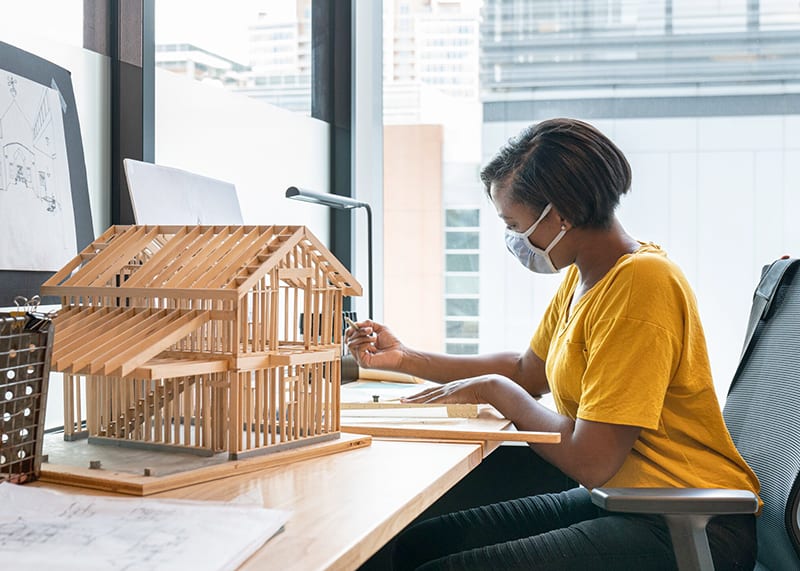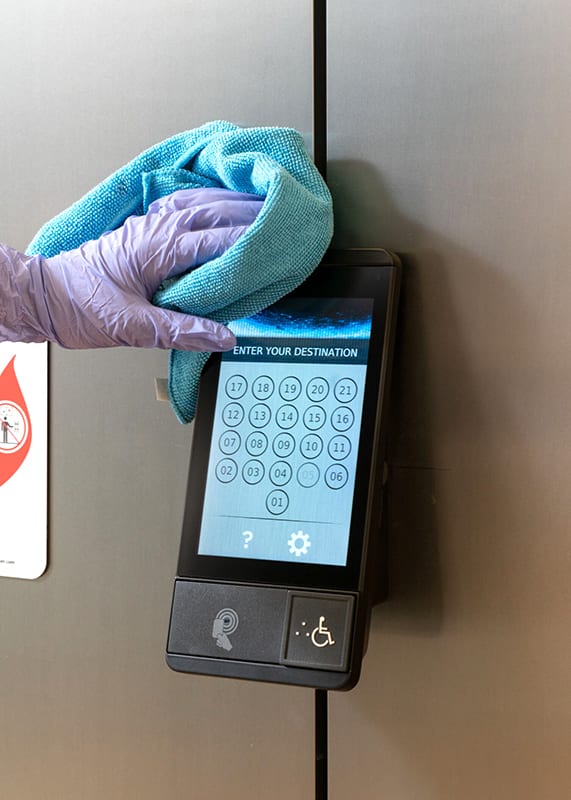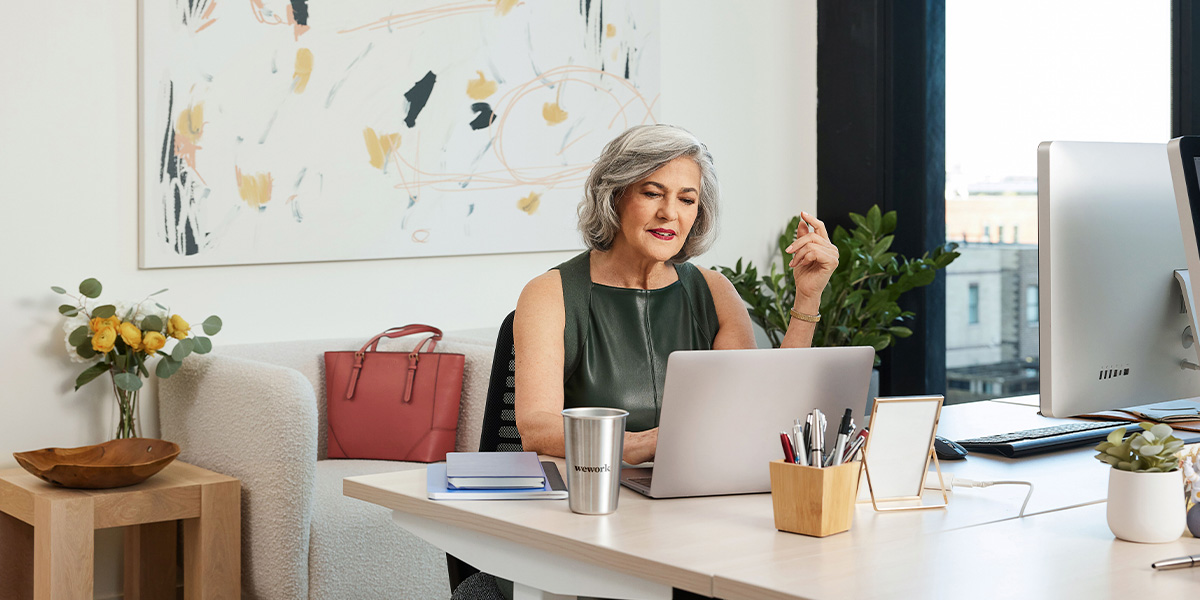The pandemic continues to impact almost every aspect of working life, from how we move around our cities to how we socialize and collaborate with colleagues and friends. Around the world, social distancing and other preventive measures such as wearing face masks have become the norm. Until a viable COVID-19 vaccine is developed, these protocols remain the most effective tools we have to safely reopen society.
- What is social distancing?
- Why is social distancing important?
- Wear a mask (correctly) and leave it on all day
- Don’t be afraid to be assertive
- Don’t shake hands
- Be social online
- Six feet is good, but 10 feet is better
- Watch out for high-touch surfaces
- Check in with your employees regularly
- If in doubt, overcommunicate
- Wash your hands often and wipe down surfaces regularly
- Telecommute if you can, stagger your schedule if you can’t
- How can you socially distance with WeWork?
Workplaces have adapted to COVID-19 in different ways. For some, face-to-face interactions are an unavoidable aspect of how companies operate. For others, socially distanced office layouts and decentralizing teams provide a way to keep employees comfortable and safe in the office.
Regardless of how your business has adapted to a new way of working, this is undoubtedly a strange time for teams returning to the office. We’ve collected some expert tips for social distancing in the workplace to ensure that when you or your team is ready to return, you can do so in a way that prioritizes health, safety, and employee happiness. Before we dive in, let’s consider what we mean by social distancing.
What is social distancing?
Social distancing is the term given to a set of measures intended to prevent the spread of COVID-19 by limiting physical contact between people. This means maintaining a distance of at least six feet (two meters) between individuals from different households, avoiding crowded spaces whenever possible, and refraining from everyday social interactions such as hugs and handshakes.
Why is social distancing important?
Scientists are still learning about precisely how COVID-19 spreads, but it’s now widely understood that one of the main ways the virus is transmitted is by hitching a ride on microscopic droplets exhaled into the air. For that reason, the most effective way to prevent the spread of COVID-19 is to keep our distance from one another, wear a protective face mask when in public, and avoid physical contact with people outside our households.
“Since the virus that causes COVID-19 is spread from person to person through physically close social contact, the best approach to prevention we have right now is to keep people from being in close contact as much as possible,” Dr. Malia Jones, a social epidemiologist at the University of Wisconsin in Madison, told Healthline.
Many people infected with COVID-19 show no symptoms, meaning it’s not always possible to know who has it. That’s why it’s important to keep your distance even if you feel well. When used in conjunction with regular handwashing and enhanced cleaning techniques, social distancing measures can help to greatly reduce the spread of the virus in office environments.
Wear a mask (correctly) and leave it on all day
Evidence shows that most people infected with COVID-19 have very mild symptoms or no symptoms at all. Wearing a face mask, even when you feel healthy, greatly reduces the risk of unwittingly passing the virus on to another person. The more people who wear masks in public, the more effective this method is at halting the spread of the disease.

Here are some tips from the Centers for Disease Control (CDC) on how to wear a mask correctly:
- Wash your hands before putting the mask on
- Place the mask over your nose and mouth, securing it under your chin
- Make sure the fit is snug and you can breathe easily
- Once secured, avoid touching the mask or your face
- Consider using a washable cloth mask
Don’t be afraid to be assertive
Every workplace is different, and some colleagues may take a more relaxed approach to social distancing rules around the office. Don’t be afraid to politely ask others to keep their distance if you’re feeling crowded. People are gradually adjusting to a new way of working, and small assertive interactions like these will help to shape an office environment that’s safe for everybody, as well as comfortable to work in.
Don’t shake hands
It’s a tough habit to break, but train yourself to resist the natural impulse to shake hands with visitors and new colleagues around the office. The Rockefeller University, which specializes in medical and scientific research, has a few suggestions for alternatives—including bowing and tapping feet. Of all of these new styles of greeting, it’s elbow bumps that have become especially popular in the workplace.

Bumping elbows may seem silly at first, but casual interactions like these help to lighten the mood around the office, while at the same time reinforcing the new social distancing guidelines.
Be social online
Having potentially spent months working from home with just a few houseplants for company, it’s only natural that some returning employees will be eager to catch up with colleagues around the coffee machine. To avoid crowding, buildings should use signage to make it clear that common areas like the break room and the kitchen have new maximum occupancies.
In a recent blog post, Microsoft suggested establishing virtual spaces such as Teams channels and Zoom events for coworkers to socialize and have fun. Activities such as live yoga sessions and after-work trivia nights maintain a sense of togetherness and allow for any colleagues working remotely to join in.
Six feet is good, but 10 feet is better
Environmental factors such as open windows and desk fans have been shown to help the virus travel more than six feet, so when rearranging furniture to de-densify the office and encourage proper social distancing, aim to create as much space as you can between desks and coworkers.
“Six feet is good, but 10 feet is better,” Dr. Joseph Allen, director of the Healthy Buildings program at the Harvard School of Public Health, told The Wall Street Journal.
WeWork offers flexible office solutions for businesses who need some extra elbow room to maintain social distancing for their teams, or for those who simply don’t have the space required to redesign the layout of their workplace.
Watch out for high-touch surfaces
While masks reduce the transmission of COVID-19 through droplets in the air, the virus can also be spread through contact with contaminated surfaces. This is why it’s important to wash your hands regularly and avoid touching your face and mask.
Identify high-touch areas around the office, such as door handles and switches, and get into the habit of using your knuckles or elbows to push buttons and operate faucets. “If you can, take the stairs,” Dr. Allen told The Wall Street Journal. “If you can’t, don’t board a crowded elevator, unless the lobby is more crowded. Don’t touch buttons if possible, though it is fine to use your elbow or even fingers as long as you avoid touching your face before cleaning your hands.”

WeWork has introduced more intensive and frequent cleaning regimens in all areas. Consider installing hand sanitizing stations at strategic positions around the office to further reduce the chances of spreading illness.
Check in with your employees regularly
Before anyone returns to the office, it’s important that you clearly communicate the kinds of changes workers can expect to see, from one-way systems and behavioral signage to new social distancing guidelines.
Check in regularly once employees have returned to make sure everyone is comfortable and aware of the new guidelines, and address any concerns around social distancing by making appropriate changes to the office layout. Don’t just assume that team members are happy. Be transparent and willing to adapt.
Have a clear channel of communication for reporting illness and make sure employees are aware of their legal rights during the pandemic, particularly those with vulnerable family members.
If in doubt, overcommunicate
Whether your team is working remotely or in a socially distanced office, some workers may very likely feel isolated, confused, or anxious about the new setup. Host regular updates and team meetings over your preferred videoconferencing platform to maintain a sense of unity and direction within the company, no matter how spread out you are.
The use of video is key here, as simply being able to see and read facial expressions helps foster a more human connection. Staying visible and in touch ensures everyone is on the same page, and helps to allay any fears an employee may have. “If in doubt, overcommunicate,” said Ann Francke, chief executive of The Chartered Management Institute (CMI) in the UK.
Wash your hands often and wipe down surfaces regularly
This is advice you’ve heard often already, but it bears repeating: Wash your hands regularly with soap and warm water for at least 20 seconds, and use hand sanitizer when entering or leaving the office. Alongside social distancing measures, frequent handwashing is a highly effective way to keep infection rates down and prevent the spread of COVID-19 in the workplace.
“To avoid getting anything [such as the virus] that was sneezed onto a table or door handle on your hands, and then ultimately into your mouth and nose, wash your hands often, especially before you eat and as soon as you get home from being outside,” Dr. Jones told Healthline.

Use disinfectant wipes to clean your keyboard, mouse, and the area around your desk at least once a week, and schedule a regular deep clean of your desks to keep the office sanitized and healthy.
Telecommute if you can, stagger your schedule if you can’t
A quick fix for creating more space in a crowded office is to split your team into two groups and stagger their attendance each week, with one half of the company working remotely while the other works from the office.
This alternating schedule halves the number of workers in the office on any given day, allowing everyone enough room to properly socially distance. This, in conjunction with implementing a deep-cleaning regimen on switchover days, can greatly reduce the chance of COVID-19 spreading between groups of employees.
If a staggered schedule isn’t right for your entire company, consider which jobs could be carried out from home, or at a satellite office, and offer those workers the option to telecommute. The Rockefeller University’s social distancing guide recommends that any work activities that can be accomplished remotely be done remotely.
How can you socially distance with WeWork?
At WeWork, we’ve implemented a range of new measures so that your team can work safely and confidently in our coworking spaces while observing social distancing guidelines. We’ve de-densified common areas by removing furniture and creating buffer zones through staggered seating, added highly visible behavioral signage to guide workers around newly laid-out spaces, and offer large, adaptable private offices to allow plenty of room for remote working teams.
Whether you’re looking for a satellite office closer to home or to decentralize into shared spaces across the city, our flexible workspaces allow you to balance office density with the health, comfort, and safety of your workers.
Steve Hogarty is a writer and journalist based in London. He is the travel editor of City AM newspaper and the deputy editor of City AM Magazine, where his work focuses on technology, travel, and entertainment.
Rethinking your workspace?








